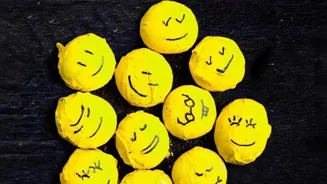Unveiling DNA's Marvels: Explore 7 Fascinating Facts About Genetics. Dive into the wonders that shape life itself
In the bustling landscape of modern science, one field continues to unravel secrets with
remarkable precision: genetics. At its heart lies DNA, the blueprint of life. It is a complex molecule which holds the instructions for building and maintaining all living organisms.
For the common man, the world of genes and chromosomes might seem complex, but understanding the basic facts about DNA can be truly fascinating. Let's delve into seven wonders of DNA, expressed in a way that is easy to follow.
Dna is your body's instruction manual passed down from parents
Think of DNA as an incredibly detailed instruction manual. Instead of explaining how to assemble a toy or cook a dish, this manual tells your body how to grow and function. It contains all the information needed to build cells, tissues, and organs.
This instruction manual is passed down from parents to their children, defining who they are and some possible things about them, like their eye color or their height. The wonder lies in the fact that one tiny molecule holds so much information about you.
It determines how your body will work from the moment of your birth.
DNA bases build proteins for cell functions efficiently
DNA is made up of four chemical bases: adenine (A), guanine (G), cytosine (C), and thymine (T). The sequence of these bases tells the body how to build different proteins, which do almost all the work in our cells.
These include things like building new cells, breaking down food, and fighting off infection. This shows us how complex and powerful it is, to be able to direct a whole process.
DNA sequence uniqueness shapes human life complexities
Although the structure of DNA is the same throughout the human body, it is the specific sequence of the four bases that makes each person unique. This sequence provides the detailed instructions for building a human.
Therefore, it is very important to know that, your entire life is based on something very small. From a simple cell to a very complex organ.
dna in every cell provides vast info for scientists
This might sound obvious, but every cell in your body, with a few exceptions contain a copy of your entire DNA instructions. That means from the cells in your skin to the cells in your brain carries the same set of instruction. This makes DNA easily accessible for scientists to study.
They extract DNA from samples like saliva or blood. This means that even a tiny sample can provide enormous amounts of information about a person, their background and some potential health issues.
Cells hold body's manual with redundancy for easy access
It is truly amazing that the entire instruction manual for building and maintaining your body is present in almost every single cell. This redundancy ensures that the body always has access to instructions it needs, no matter where it is looking.
It is like having multiple copies of an important document, always making sure that it is securely stored and readily available when needed.
DNA's ubiquitous presence holds key to better health insights
Knowing that DNA is present everywhere has enormous implications for understanding how our bodies work and what may go wrong. It may lead to a better treatment and diagnosis. Genetic information is constantly being developed to help us understand ourselves to our core.
The possibilities are endless, emphasizing just how important and widespread DNA is.
99.9% DNA similarity, 0.1% unique differences make us
It is common to hear that everyone is unique and special. Everyone has different abilities, appearances and personalities. But, genetically, humans are incredibly similar. In fact, 99.9% of our DNA is exactly the same to other people. That means only 0.
1% of your DNA makeup accounts for the differences we see in looks and characteristics. That small decimal is responsible for all the things that makes you unique and different from everyone else. It is that fraction that determines eye color, hair type, height and other things.
Human DNA: Commonality and Variability Explained
This level of similarity points us to the common background of all human beings. But there is also an astonishing amount of variation between people with only 0.1% difference in it. This explains how a small piece of DNA can determine who has a higher likelihood of developing certain diseases.
It can also determine how individuals respond to certain medications.
Interconnectedness in human genetics shapes personalized medicine
With high similarities with each other, it shows that people are interconnected. With only a minor change it showcases different attributes and personalities. It highlights the delicate balance of human genetics.
By understanding both the commonalities and variances in our DNA, researchers can develop more efficient and personalized medicines for everyone.
DNA in cells tightly packed into chromosomes
If you could somehow stretch out every strand of DNA present within a single human cell, it would be about 2 meters long. Now consider that your body has trillions of cells! To fit all that genetic material inside tiny cells, DNA has to be tightly packed and organized.
It’s like trying to fit a very long rope into a very small box. The cell must wind and fold the DNA into dense structure called chromosomes.
DNA stored efficiently in chromosomes for cell functioning
This arrangement is so complex and efficient that DNA can be stored safely and efficiently within the nucleus of each cell. The structure of chromosomes also helps to ensure that DNA is copied, or replicated properly when cells divide.
This packing process is crucial for the functioning of organisms. Chromosomes make sure the DNA is managed well.
DNA packaging crucial for gene regulation & cell function
The compacting ability of DNA is an enormous feat of engineering at the cellular level. Without it, our cells wouldn't work properly because DNA would be unwieldy and fragile.
Understanding how DNA gets packaged and unpackaged is crucial for understanding how genes are turned on or off, which is vital for cell differentiation and development.
Daily DNA damage repaired by cellular mechanisms
Life can sometimes be challenging, and surprisingly, your DNA also faces its share of daily damage. Things like exposure to the sun and just the normal processes inside your body can cause damage. But don't get scared. Our cells are equipped with all kinds of repair mechanisms.
These mechanisms constantly scan the DNA for errors, that try to fix them before it continues to cause problems.
Repair systems prevent cell mutations for disease prevention
It's like having a maintenance team working 24/7 to keep your car running smoothly. These systems are able to identify and correct problems ranging from simple base damages to more complex strand breaks. These teams uses the correct codes and fixes the damage in the cells.
The accuracy and effectiveness of these repair strategies are essential for preventing changes(mutations) that could lead to diseases.
DNA repair prevents mutations, impacts health & aging
Without DNA repair mechanisms, all living organisms would be extremely prone to mutations, which can result in severe health issues. Understanding these repair processes will not only lead to ways to avoid genetic diseases but also to strategies for slowing down the aging process.
The ability of DNA to repair itself highlights the tough and resilient nature of life at its most simple level.
Most DNA is not genes, vital for gene regulation
It is common to think that most of the DNA is made up of genes. Genes are the part of your DNA that gives instructions for making proteins. These are the units that determine particular traits. But here is a surprise: Gene only makes up a small fraction of your total DNA.
The function of the remaining DNA is not fully understood, but it is believed to be very important for regulating gene activity.
Non-coding DNA regulates gene expression like volume control
Some of this non-coding DNA participates in controlling when and where genes are turned on or off, which is vital for development and adaption to environmental changes. Imagine it: It's like having a volume controller for each of your genes, enabling them to be adjusted depending on the situation.
The volume controller determines how much protein is produced.
Non-coding DNA complexity and potential breakthroughs
The existence of such non-coding DNA shows how complicated genetics is, and how our genes are formed. Much of it is believed to have no known function, with scientists calling it "junk DNA". It is there because it is needed, but does not provide the instructions to assemble any type of protein.
Further exploration in this area may lead to breakthroughs in grasping various biological processes and diseases.
Scientists revolutionize gene editing with CRISPR technology
In the last few decades, scientists have developed ways to not only read DNA but also to edit and manipulate it. Gene editing technologies like CRISPR-cas9 have revolutionized what scientists can do at a base level.
This is to make very precise changes to DNA, offering the potential to correct mutations that cause diseases. CRISPR technology, holds the ability to switch off diseased genes in children.
DNA editing tech: powerful yet ethically challenging
This technology works like a word processor. You can cut, copy, and paste DNA sequences with remarkable accuracy. This has opened up great possibilities in treating genetic diseases, creating new plants, and improving medical processes. However, gene editing leads to ethical considerations.
This shows that the power has to be used safely so these techniques are used responsibly.
DNA: the incredible blueprint of life, always revealing new secrets
The world of DNA can be seen as something truly extraordinary. These seven facts offer a little view into the intricacies of the molecule- the blueprint that forms the foundation of our complete existence.
From understanding that DNA is the human body's instruction manual, to knowing that researchers are still exploring secrets every day, there is always something to learn and to appreciate about the wonders of genetics.
AI Generated Content. Glance/InMobi shall have no liability for the content










